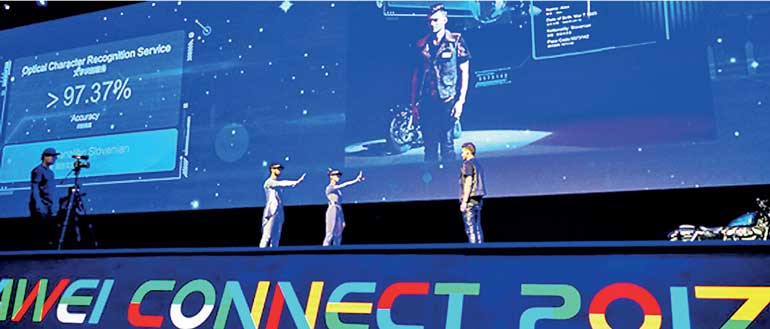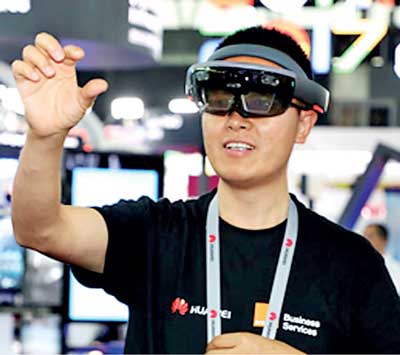Tuesday Dec 16, 2025
Tuesday Dec 16, 2025
Monday, 11 September 2017 00:00 - - {{hitsCtrl.values.hits}}

Guo Ping, Huawei’s Rotating CEO, gave a keynote entitled Grow with the Cloud: Enabling an Intelligent World at Huawei Connect 2017 last week in Shanghai
Huawei Technologies Co. Ltd., the Chinese multinational giant in information and communications technology (ICT) solutions, last week declared that countries, communities and companies can grow better and smarter with the “Cloud” and backed this proposition by unveiling a host of ground breaking products, services and initiatives.
The platform Huawei used to spread the message and unleash its new solutions was the three-day Huawei Connect 2017 in Shanghai which drew over 20,000 participants including partners, customers, developers, IT experts and media from over 150 countries including Sri Lanka.
The theme of this year’s event was ‘Grow with the Cloud’, focusing on the practical implementation of Huawei’s cloud strategy, first unveiled at last year’s event. Topics under this theme include business, technology, and ecosystem strategies in the cloud era.
Headquartered in Shenzhen, Guangdong, China, Huawei is the world’s ninth-largest information technology company by revenue. In 2015, it boosted revenue by 37% to $60.8 billion. Together with telecom carriers, Huawei has built over1,500 networks, helping over one-third of the world’s population connect to the Internet. Huawei enterprise network products and solutions have been widely used in more than 100 countries and regions around the world and are accelerating enterprises’ digital transformation based on Smart Connection of Everything. To date, 197 of the Fortune Global 500 companies and 45 of the top 100 enterprises have chosen Huawei as their partner for digital transformation.

The inaugural day was kicked off by Huawei’s Rotating CEO Guo Ping with a keynote entitled Grow with the Cloud: Enabling an Intelligent World.
“The cloud is a cornerstone of the intelligent world,” he said. “Society is experiencing a tangible Matthew effect in digital technology development. Because of this, as well as economies of scale in investment, clouds around the world will begin to converge – becoming more and more centralised. In the future, we predict there will be five major clouds in the world. Huawei will work with our partners to build one of those five clouds, and we’ve got the technology and know-how to do it.” In his speech, Guo Ping assured customers and partners that Huawei has made strategic investments in the public cloud domain, and will provide long-term public cloud services. The company will build a global cloud network based on its own public clouds, as well as clouds that it has built together with partners.

Guo likened Huawei’s strategy to the three major airline alliances – SkyTeam, Star Alliance, and Oneworld – which take passengers wherever they need to go in the world. Huawei Cloud, he said, will open up the world to its users. He went on to explain Huawei’s business model for the cloud, emphasising that Huawei will monetize technology and services, not data. He said, “Huawei’s Cloud DNA is made of a unique combination of technology, security, services, and shared success.”
Huawei’s ‘Cloud DNA’ explained
First, Huawei is a tech company. Building on 30 years of R&D experience, Huawei has decided to invest heavily in cloud platforms, while developing new capabilities in fields like big data and artificial intelligence to meet customer demand for service upgrades and innovation.
The second element of Huawei’s Cloud DNA is security. Huawei provides end-to-end security solutions – from chipsets to services – that effectively address the challenges of cloud security. Huawei’s full-stack capabilities ensure a level of security that far succeeds that of any independent IT system. The third element is service. Unlike companies that were born in the cloud, Huawei grew with the cloud. The company’s own IT architecture is extremely complex, so it understands the needs and challenges of large global companies, and is well positioned to help governments and large enterprises go digital.
Shared success is the final element of Huawei’s Cloud DNA.
At last year’s event, Huawei laid out its vision to help cultivate a thriving and diverse ecosystem. At the time, Guo proclaimed that Huawei has its sights set on only 1% of that ecosystem. For the remaining 99%, Huawei will work with its partners to bring their products to 172 countries and regions, achieving business success together. Guo wrapped up his keynote with details on Huawei’s hybrid cloud solutions that specifically target the needs of governments and enterprises, including a diverse array of success stories from around the world. Architecturally speaking, Huawei Cloud builds on the company’s decades of experience in devices, networks, clouds, and other digital domains, and is better equipped to achieve synergy between devices and the cloud. Moving forward, Huawei will continue leveraging the strengths of its global platform to build an open ecosystem that thrives on shared success.
Building a cloud network with global coverage; launch of new Enterprise Intelligence cloud services
Zheng Yelai, President of Huawei’s Cloud BU, also presented on the first day of the event, sharing his team’s progress on Huawei Cloud. He shared case studies from 12 automobile companies (including Volkswagen and Mercedes-Benz), Philips, the Commercial and Industrial Bank of China (ICBC), and several government service platforms that have chosen to use Huawei Cloud and the cloud services from Huawei’s partners. Zheng Yelai said, “Our people have an in-depth understanding of our customers’ business scenarios, whether they’re working in R&D, marketing, or sales. We keep a close eye on the needs of our customers, and innovate accordingly. We’ve developed Huawei Cloud to help enterprises go digital more smoothly, and help ensure the success of more companies who are willing to innovate.”

Huawei also announced the launch of its new Enterprise Intelligence cloud services, which the company will provide with a platform of general and scenario-specific solutions. This combination of Huawei Cloud and EI makes Huawei Cloud more intelligent, and will help create greater industry value with new advancements in technology.
Huawei’s public clouds and private clouds have a unified architecture, support smooth evolution, and deliver a consistent experience. Companies can efficiently and freely deploy their services on public or private cloud platforms, which readily support service migration and expansion. To prevent vendor lock-in, Huawei offers hybrid cloud solutions that enable integration with third-party public cloud platforms, including those from Amazon and Microsoft.
Huawei has worked with its partners to build a cloud network that has global coverage, providing complete solutions that help Chinese companies go global, and that also help companies outside China enter the Chinese market. Huawei Cloud is the result of innovations in hardware, software, data, connections, and architecture. At HUAWEI CONNECT 2017, Huawei launched flagship solutions in each of these domains to further enable the digital agenda of customers across nine different sectors, including government and public utilities, finance, telecom, energy, transformation, and manufacturing.
To expose its ICT capabilities to developer partners, Huawei also launched its new software development cloud, DevCloud 2.0. As an R&D cloud platform that integrates Huawei’s 30 years of experience in R&D, cutting-edge R&D concepts, and advanced R&D tools, DevCloud 2.0 will expose over 3,000 of Huawei’s ICT capabilities through public APIs, and open the doors to 20 local OpenLabs around the world to developers. The end goal is to make software development simple and more efficient, helping developer partners innovate and successfully monetise new services.